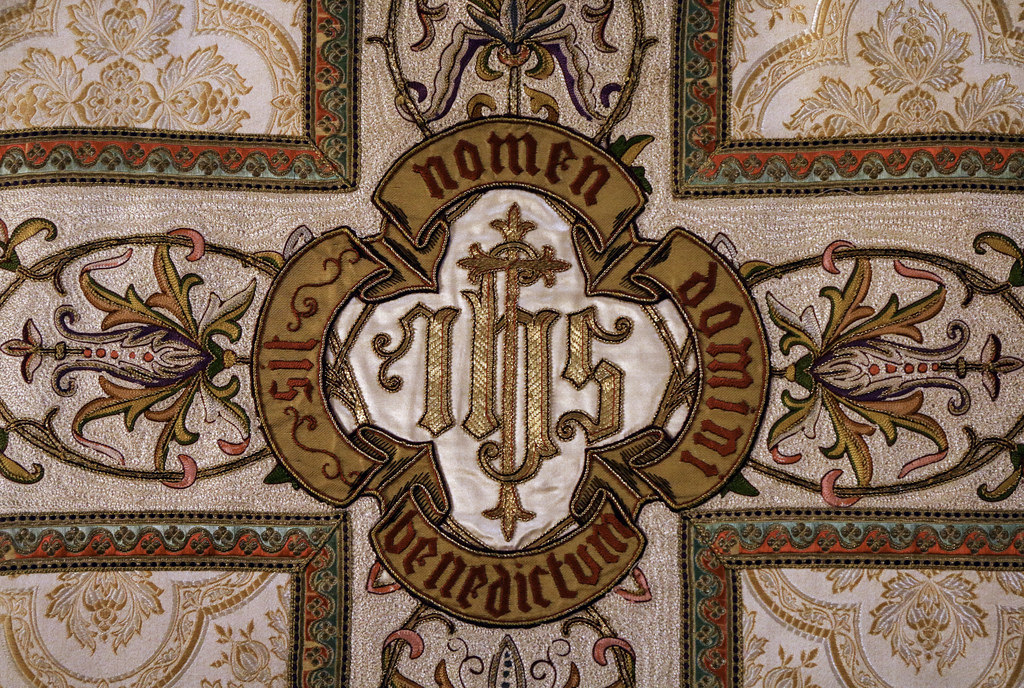The Woke Fallacy that Christian Art Generally Portrays Christ as a Northern European man
Where Have All the *!*?-ing Psalms Gone?
Master of Sacred Arts at Pontifex University With a Concentration in the Theology of the Body Taught by Christopher West
Master of Sacred Arts at Pontifex University. Sign up today.
Painting of St Joseph
A New Blog on Catholic Culture and Beauty by Pontifex U. Professor, Dr Carrie Gress
Carrie Gress is at once a mother, journalist and writer, and a philosopher who specializes in beauty and aesthetics and studied Jacques Maritain for her doctorate.With such a wide range of interests, all of which are integrated with her faith, I would say she was a Renaissance lady if I wasn't somewhat negative on Renaissance culture! So, how about baroque lady instead?
Saints of the Roman Canon, St Agnes (January 21st), The 'Lamb' of God
This, past Sunday, January 21st, was the Feast of St Agnes. Early and Eastern images portray Agnes without attributes, and even as late as this 9th-century Roman mosaic, she is pictured as simply a generic virgin martyr (see example). But as early as the 6th century she begins to be portrayed with a lamb.
A One-Minute Daily Spiritual Exercise for Cultivating Faith, Joy, Gratitude, an Ability to Apprehend Beauty...and It Might Even Be a Treatment for ADHD!
Try it for 30 days, and if you don't like it, we'll return you misery with interest!
Here's a quick and simple exercise I have been doing daily for nearly 30 years and it has brought such spectacularly positive results in my life that have accumulated steadily and incrementally ever since I started.
Every day, I jot down on a scrap of paper a 'gratitude list'.
The gratitude list is a list of good and beautiful things that have been given to me today for which I offer thanks to God. I put down the 'essentials' of life that are true for today, for example, I am alive, I have a bed to sleep in today, I have somewhere to live, food for today, clothes to wear and so on. I then put down all the little events specific to that day that go beyond what is necessary for life, you might call these 'luxuries', for example, sunshine on this January day (sorry New Hampshire), a kind word here, the relationships with others that I have and so on.
Actually writing the list is important - it forces me to crystallize the thought in my mind that much more concretely and makes the exercise more powerful. So nice thoughts in the shower, or on my morning walk don't count. It's not that there's anything wrong with that but it doesn't work as well for this exercise. I reach for pen and paper.
Also, I don't wait to feel grateful before I put them down - I write down what I ought to feel grateful for! The idea is that this exercise changes how we feel, and we grow in gratitude over time even if we don't start out that way. So right now I am grateful for a huge cup of steaming coffee! Fantastic!
Then I go further, I write down the bad things happening in my day and thank God for those too.
It may sound perverse, but this is powerful for turning around my attitude to what is happening to me. I believe that all that is good comes from God and that once we hand ourselves over to his protection and care he will look after us. While it is undeniable that there is evil and suffering in the world, these things to do not come from God, for a God that is all good cannot be the creator of something bad. Rather, he permits bad things to occur in order that a greater good can come out of them.
For this reason, I make a point of putting down negatives and disappointments of the day on the gratitude list too, knowing that a greater good must be coming out of it (even if I can’t see it yet). The realization of this helps me to deal with adversity with dignity and when I praise God for them (as St Peter tells us to do in one of his first letters) it helps me actually to feel good about them.
I look to the example of the saints for inspiration, including that of St Peter himself, who dealt with greater suffering than I have ever had and praised God for it. So I can say to myself, okay, it's pretty bad that I missed my train...but I'm not being crucified or stoned to death as St Stephen was. The account of St Stephen in Acts shows us that hope in God transcends all suffering if we can follow the promptings of God's grace. This exercise helps me to move that ideal incrementally.
Furthermore developing the habit of seeing minor irritations in this way is invaluable when more serious things happen to me. I have not had to face stoning or torture in a concentration camp, but in 30 years I have experienced some genuinely bad things - arising from the malice of others, my own selfishness or foolishness - or just plain bad luck. Having practised an attitude of faith and hope that transcends the small reversals on the regular basis, it is easier to see that what is true for the little things is just as true for serious disappointment and suffering. It has to be so. After all, if it's not true for the big things too, then it's not true at all. This exercise helps me to feel what I know intellectually to be true.
People can go on the gratitude list too: those we love...AND those we don't! If I have a resentment against a person, I put the person I don't like down and pray for that person too. Once written down I then pray repeatedly until I feel better, 'Please give X%#F&! everything I would wish for myself'. Sometimes it is through gritted teeth I can tell you! The more I dislike the person, the better things I ask for them. It might even be...(take your pick)...
Also, this is an exercise that can help us to enjoy what is beautiful. I am not by nature given to gratitude and can tend to take good and beautiful things for granted very quickly. So in my day, I especially look for beautiful things in the context of what might otherwise seem bad. I work on the principle that if I start to notice the little things, then it develops my appreciation for the grand vista too. One of the attributes of beauty is due proportion. If I develop the habit of noticing the parts and the details, then it helps me to see the good of the whole too. In other words, it helps me both to analyse and synthesize. These are skills that contribute to my ability to apprehend beauty - to see the part in relation to the whole, and the whole in relation to others. I suggest that every creative artist should develop this habit as part of his formation!
The dynamic of analysis and synthesis can be applied to time as well as space. In every moment there is something good happening, even if my general response to what is going on is initially bad. This how I can stop a few hurtful words before lunch influencing my sense that I am 'having a bad day', and instead allow the good to characterize the day. This is not only a better attitude to have, it is in accord with what is true. We know the day is good, objectively, because it is made by God and it is a gift given to all of us. This exercise allows us to feel what we know to be true in this regard. This is a similar frame of mind to what modern new-age therapy calls 'mindfulness' except, I would say, this runs deeper and truer. And it has a longer and broader pedigree coming out of traditional Christian mysticism.
So abandon this...
and focus more on being like the dog who waits expectantly for the crumbs from his Master's table, or alert to every murmur of his master's voice...
And this is why I say it could be an exercise that develops better concentration and attention to detail. I have wondered at times if, judged by my natural levels of concentration, I could be diagnosed with low-level ADHD. Certainly, I struggle more than I would like to concentrate on anything I'm not hugely interested in and would always rather listen to the talking book while driving the car than read it just because I can't sit still. I don't read fiction and haven't read a novel in years apart from easy-read detective stories. I like getting news in 5-minute podcasts and can hardly focus on a newspaper. I don't know how this compares with the norm for the population (and I have often wondered if it's down to all the coffee I drink) but regardless, this exercise does help to at least to get some things done and to enjoy the process as well.
It's not always a bad thing. I like squirrels and I'd rather be looking at a squirrel than contemplating my poor powers of concentration anyway. Joking aside, I know there are many whose lives really are made extremely difficult by a chronic inability to stay focused. Even so, I wonder though if a daily meditation of this type might help even those who are genuinely ADHD? It can't do any harm. And it is a task that needs very little attention time in itself. It takes me a minute or two at most to do this. The effect is cumulative - I was told initially to try it for 30 days and see how I felt at the end of that time.
So, I encourage to try it yourself and see how it goes. Remember, the Divine is in the detail!
Some of you may wonder what prompted my starting this habit nearly 30 years ago? The answer is that I met someone, an elderly man called David, who told me something that shook me when I heard it - misery is optional. When I heard it, my first reaction was to be certain he was wrong. I was certain because I was miserable, and if he was right, I would have to admit some terrible truths. First of these was that David knew more about how to live happily than I did; the second was that I was responsible for my unhappiness. My pride was such that I couldn't possibly admit either of these things easily.
Prior to meeting David, if I met a happy person the only way I could reconcile my misery and intellectual pride with their joy was to assume they were deluded or foolish, and probably both. Happiness, I had always thought, is the preserve of the stupid and superficial thinkers. When you are deep thinking and intelligent like me then you understand the profound truth that life is miserable. But David opened my mind by presenting me with a version of Pascal's wager (although I didn't realise that this is what he was doing), he challenged me to try it.
I had met David through a mutual friend who had invited me to coffee on the King's Road, in Chelsea when I was living in London. (It was a restaurant called Picasso's - I don't know if it's still around.) David was talking to my friend when he said this provocative statement, but when I heard him say it, I felt I had to intervene. In my unhappiness, I was one of those people who was so irritated and envious of happy people that I considered it a service to explain to them how deluded they were. So I interrupted and began to explain to him that although he might think he was happy, in fact, he was really unhappy (absurd as this sounds). David let me speak for a while, as I tried to reconcile the irreconcilable, and then cheerily stopped me: 'Please yourself, lad,' he said. 'But why don't you try the theory out?'
My friend then chimed in and said he had been doing a simple program of daily prayer and meditation that David had suggested to him and this had changed his outlook dramatically and encourage me to do the same. It was this personal recommendation from someone I liked that made me pause.
David told me he would happily show me these things too if I was interested. 'Try it for 30 days, do everything I suggest, and if you don't like it we'll return your misery with interest!' he said. The process that he gave me was called the Vision for You process. It was a daily routine of prayer, meditation, contemplative prayer and good works that are both simple and practical and involved about 10 minutes a day, plus a weekly voluntary commitment of service anywhere where I could be of use. I decided that it couldn't do any harm to try and he wasn't asking for money, so I thought I'd give it a go.
Something that persuaded me was that I had noticed a change in the positive in my friend, I thought, in recent weeks. He had started to become irritatingly cheerful and couldn't be.
The gratitude list is just one of the simple spiritual exercises he gave me and I would say that without a doubt it works. I can't prove it, of course, but I am convinced enough by it to have kept going with it daily for a long time. Another one of the exercises he gave me was to get on my knees in prayer every day and ask God to look after me so that I could give glory to Him and be of service to my fellows. As David said to me all those years ago put it, the gratitude list is written proof that when you asked God to look after you today, he answered your prayers.
Not that I saw it that way initially. David wrote my first gratitude list for me because I didn't really feel grateful for anything. So he took pen and paper and asked me, you are alive today aren't you? He waited for me to say, 'Yes' and then wrote it down. 'And you have clothes to wear?' Again he waited for me to agree to each item so that I confirmed that what was going down was true. 'And food to eat, for today at least?'...and a roof over my head? And a bed to sleep in? When I had agreed to each item as being true for me, he paused and said, 'You are now ahead of billions of people in the world who don't know where their next meal is coming from. Here is the evidence that the day is good. You have no good reason for complaint.'
David told me that this whole process, the Vision for You, would do more than raise my baseline of misery. It would give me a life 'beyond my wildest dreams', engender a deeper faith in God and help me to discern and realise my personal vocation. Some of you may remember a post from a long time ago in which I described how I became an artist. It is here - Discerning My Vocation as an Artist. David is the man I was talking about in this earlier article. He showed me how to be doing what I do now! It is also the process that converted me to Catholicism, and David was my sponsor when I was received into the Church in 1993 nearly five years later. Sadly he died of a heart attack in 1998 - nearly 20 years ago now. I would have loved him to see just how much this process, which I still practice to this day, continues to give me so much in my life and in the lives of people that I have passed this on to over this period. There are dozens.
I don't have the space to describe the full process here - I have a book manuscript ready for publishing which is over 200 pages long and which describes the whole story in detail. Once I had the initial daily routine as a habit and I decided that it was working, David introduced me to a series of deeper structured reflections and it was at these that included the discernment process. All in all, it took several months. It was work, but it was worth it!
David said that he would give freely of his time and consideration, but only on condition that if I benefited from it, I would be prepared to pass it on, in turn, to any others who wanted what was on offer. This is why I am happy to help anyone who is interested in following this process today if they are serious about doing it. If you have questions about it, do feel free to contact me, but in the meantime here is a document which contains a summary of the process, the spiritual exercises, the daily routine and the discernment process.
Master of Sacred Arts at www.Pontifex.University - a cultural, intellectual and spiritual formation in beauty and creativity for artists, patrons of the arts, and anyone who wants to contribute creatively to the establishment of a culture of beauty today.
Christ in the Realm of the Dead, by Joakim Skovgaard, 1891, 'the Danish William Blake'!
"Style and content are both critical if we are to portray the human form with dignity. It's not just what we paint, but how we paint it." "The Master of Sacred Arts program of www.Pontifex.University discusses in great depth how this consideration of the way in which we paint the human figure has influenced profoundly all the great Christian styles of art."
Here is the latest video presentation, by Bill Donaghy of the Theology of the Body Institute in Philadelphia, recorded just after the Easter Triduum last year. He discusses Christ in the Realm of the Dead, painted between 1891-94 painted by the Danish artist Joakim Skovgaard (1856-1933).
I did not know anything about this artist until I saw Bill's talk. Although not so obviously drawing on the Greek ideal, his style does remind me, in many ways, of William Blake. The dramatic touch in composition, the coloration look similar. And just like Blake he does not conform to the academic styles that dominated in the period that he painted.
While Christian artists are not bound to follow traditional styles (although I would argue they would need good reasons to depart from them) they must consider a style that has the right balance of naturalism and idealization. This is especially important when portraying the human form nude. Style and content are both critical if we are to portray the human form with dignity! It's not just what we paint, but how we paint it.This artist has created a work of great power without being prurient. He chooses poses that avoid revealing private parts - this is especially appropriate if portraying fallen man, for they are meant to be private in him more than in any other anthropological state. That is why we wear clothes - or we ought to - in most situations!
The drama of this moment which indicates, as Bill tells us in his commentary, 'where Adam fails Christ succeeds'.
https://youtu.be/5l19GX6dls8
The Master of Sacred Arts program of www.Pontifex.University discusses in great depth how this consideration of the way in which we paint the human figure has influenced profoundly all the great Christian styles of art.
Pontifex University is an online university offering a Master’s Degree in Sacred Arts. For more information visit the website at www.pontifex.university
Why Paint? Art is Not for Art's Sake, for God's Sake!
Mother Teresa of Calcutta used to say that “the money in your pocket is not yours, it belongs to God.” The same is true of all the gifts you have received.
By Deacon Lawrence Klimecki; this article originally appeared at www.DeaconLawrence.org
What is the purpose of artistic talent?
I am sure most, if not all of us, are familiar with the opening of a movie produced by MGM Studios. It depicts a roaring lion surrounded by the words "Ars Gratia Artis." This is the Latin translation of the phrase "art for art's sake."
"Art for Art's Sake" is a phrase coined about 200 years ago to express a philosophy that the true value of art lies in the art itself; that art should be divorced from any instructive, moral, or useful function. In other words, "true art" serves only itself.
But for the thousands of years prior to the early 19th century, art served a purpose, it served the community. For the Christian artist, art was and still is, a way to teach, promote Christian morals and values, and serve the common good. And because we share in God's creative force as sub-creators, we find an endless number of ways to accomplish that.
Mother Teresa of Calcutta used to say that “the money in your pocket is not yours, it belongs to God.” The same is true of all the gifts you have received. They have been given to you by the Holy Spirit to bring the world back to God.
Saint Luke’s account of the multiplication of the loaves and fish gives us an interesting example. It is not difficult to understand the apostle’s point of view. They brought barely enough food for themselves, let alone the thousands who came to hear the Lord. But rather than send them away Jesus told the apostles to feed the multitude from their own small stores. We can easily imagine some reluctance to give up what little they have. But because it is the Lord who asks they do so. And Jesus takes what they have, multiplies it, and not only is there enough to feed the thousands but there is enough left over to fill twelve baskets, one for each of the twelve apostles.
God asks us to return to Him what He has given us, in order that He may give us even more.
What are your talents and how are you using them?
There is a saying that your talent is God’s gift to you, what you do with it is your gift to God.
It is easy to use our gifts selfishly, and keep them to ourselves. For artists this may lead to the “ivory tower” mentality that no one can tell you what to do, you must follow your “muse.” That is art for art’s sake.
Our gifts were not given to us to indulge in own private whims, they were given to us to help feed the children of God. “Art for art’s sake,” is a lie that feeds into our ego. It seduces us into thinking we can make our own way without acknowledging the source of that artistic ability.
"The Parable of the Talents" teaches that we will one day be called to give an account of our stewardship over the riches we have been given. Will you be ready when that day comes?
______________________________________
Pontifex University is an online university offering a Master’s Degree in Sacred Arts. For more information visit the website at www.pontifex.university
Lawrence Klimecki is a deacon in the Diocese of Sacramento. He is a public speaker, writer, and artist, reflecting on the intersection of art and faith and the spiritual “hero’s journey” that is part of every person’s life. He maintains a blog at www.DeaconLawrence.org
The Holy Name of Jesus!
Saints of the Roman Canon - Abel the Just, January 2nd (EF), Dec 24 (OF)
Abel, the son of Adam is mentioned in the Canon of the Mass as Abel the Just. It hasn't been easy to confirm, but my best information is that his feast day is January 2nd for the Extraordinary Form Calendar and I was just informed (H/T Sequoia S) that it is December 24 for the Ordinary Form calendar. His story is in the book of Genesis. You may remember his offering, a sacrificial lamb, was appropriate, which that of his brother Cain was deficient. When Cain's offering was rejected, Cain murdered Able out of jealousy. He is a hugely important figure liturgically in that his story is one that helps to establish the pattern of religious life for us, with worship and sacrifice at its heart. This is true, broadly speaking for the patriarchs, and specifically, he is often associated in this regard with Melchizedek and Abraham. I have covered both of these figures in previous postings and any who have read those will remember the mosaic from Ravenna which has the three together.

This importance is made real, by the continued references to him in the Old Testament, as well as in the Mass, of course. Here is an excerpt from the Catholic Encyclopedia:
In the New Testament Abel is often mentioned. His pastoral life, his sacrifice, his holiness, his tragic death made him a striking type of Our Divine Saviour. His just works are referred to in 1 John 3:12; he is canonized by Christ himself (Matthew 23:34-35) as the first of the long line of prophets martyred for justice' sake. He prophesied not by word, but by his sacrifice, of which he knew by revelation the typical meaning (Vigouroux); and also by his death (City of God XV.18). In Hebrews 12:24, his death is mentioned, and the contrast between his blood and that of Christ is shown. The latter calls not for vengeance, but for mercy and pardon. Abel, though dead, speaketh (Hebrews 11:4), Deo per merita, hominibus per exemplum (Piconio), i.e. to God by his merits, to men by his example.
The Ghent Altarpiece portrays this so beautifully, by connecting the two images of Abel and Cain with the fallen Adam and Eve (who have deep shadows associated with their images and who are naked, but ashamed of their nudity).



Here is an early gothic illumination, which again puts to the two important parts of the 'Kayn' and Abel biblical narrative together.

Later images, especially, Renaissance and baroque images tend to focus more on the drama of the murder, emphasizing the effects of the Fall. This is important, of course, but personally, I would like to see this aspect of offering and worship brought to our minds too, especially for images in church. Here is Titian's wonderful painting from the 16th century:
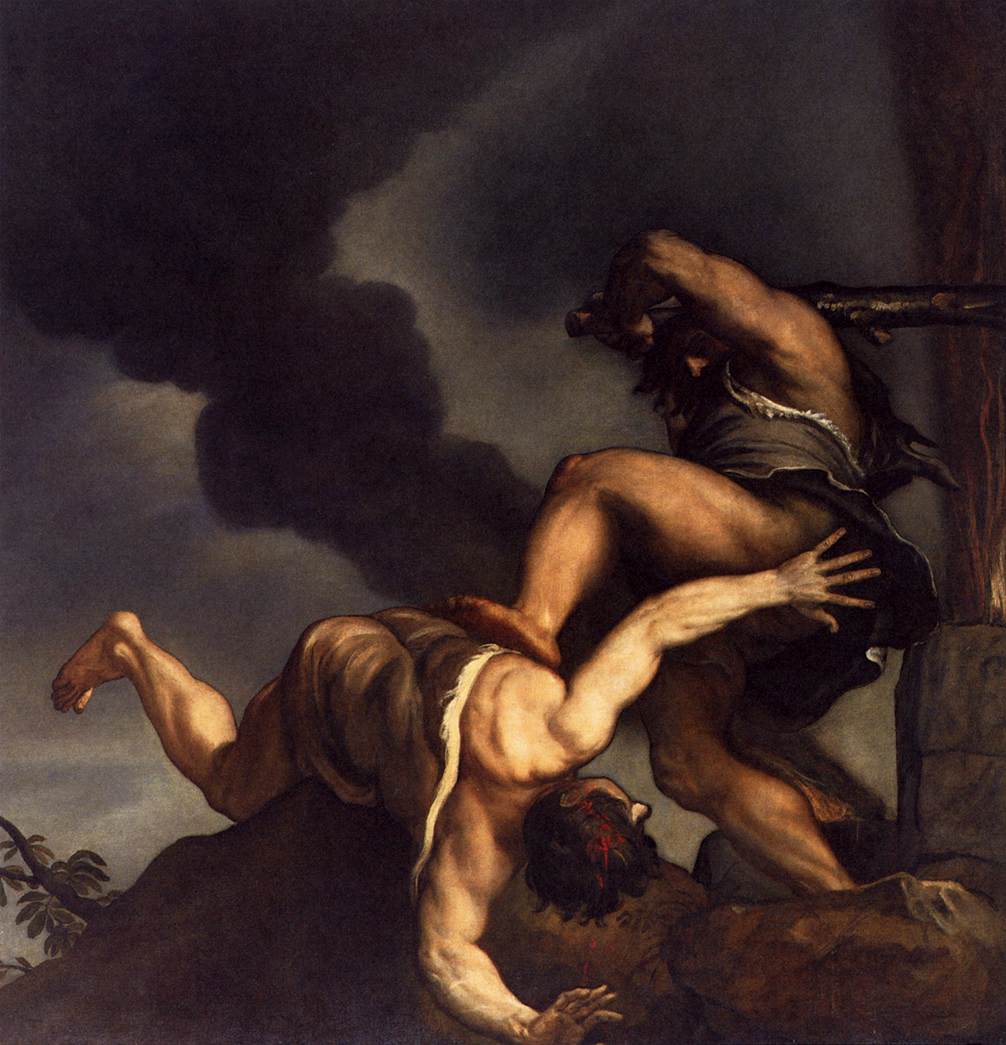
This one by an anonymous 17th-century artist does have an indication of the sacrificial altar that is just a little more obvious than Titian's.

Here is William Blake's depiction, typically idiosyncratic! He focusses on the expulsion of Cain 'East of Eden'.

This is one of a series of articles written to highlight the great feasts and the saints of the Roman Canon. All are connected to a single opening essay, in which I set out principles by which we might create a canon of art for Roman Rite churches, and a schema that would guide the placement of such images in a church. (Read it here.) In these, I plan to cover the key elements of images of the Saints of the Roman Canon - Eucharistic Prayer I - and the major feasts of the year. I have created the tag Canon of Art for Roman Rite to group these together, should any be interested in seeing these articles as they accumulate. For the fullest presentation of the principles of sacred art for the liturgy, take the Master’s of Sacred Arts, www.Pontifex.University.
Using Drones as Harmony - A Simple Way to Add to the Spiritual Effect of Sacred Music
I am wondering if the experiences of choir directors out there confirm an observation of mine about the power of a drone - that is a continuously sung note alongside the melody - to help engage people with sacred music in the right way? I have seen the drone used in Gregorian chant and Byzantine chant to powerful effect. I suggest that this is something that could be used more, especially in modern churches which are not designed with an acoustic that produces a harmonic resonance naturally. In my opinion, chant requires that faint suggestion of harmony that such a resonance lends to it, as one might hear in a gothic abbey for example, in order to have full effect as sacred music (I will explain my reasons for saying this later).
Here are my thoughts as to why this might be. One of the attributes of beauty, famously listed by St Thomas, is due proportion. When something has due proportion, each part of an object must be in right relation to each other in a way that is appropriate to the purpose of the whole. What constitutes due proportion in any particular situation is to a degree a matter of judgment, but there are geometric and arithmetical guidelines that can inform that judgment.
Beauty it seems is ordered by the number three. Going all the way back to pre-Christian classical culture, it was noticed that in the human response to things in combination - that is, in relation to each other - a minimum of three things were needed to constitute some sense of completeness in the arrangement. If there are just two in combination there can still be beautiful combinations, but there is inherent within it a sense that it is incomplete.
This is most easily explained in the natural response of most people to the combinations of notes in music. When two notes are placed in a relationship to each other, it is called an interval, and when it is pleasing it is described as 'consonant' meaning literally, 'sounding together'. However, it was also noticed that when people hear a harmonious interval, it still seems to lack something. If you ask the music theorist why this is, they will tell you its because an interval could be the basis of either a major or a minor chord, and you don't know which until the third note is supplied. When that third not is supplied, and a full chord is created and the sense of deficiency is removed. This suggests that we have hardwired into us, that pattern of the harmony of music.
There is sufficient consensus on this differing human response to an interval and chord that it has never really been questioned. Even the most secular music schools of today would concur and use this as the basis for the theory of musical harmony, even if they then go on to reject consonance as a good and promote dissonance (meaning literally 'not agreeing in sound').
Because musical harmony could be described numerically, by considering, for example, the magnitudes of pipes or strings that produced the separate notes, the assumption was made that the same numerical patterns present in musical intervals and chords could be used in any aspect of time and space in order to make the culture beautiful. It is most obviously applied in architecture, in which the dimensions of buildings can correspond to them.
So in this building below we see traditional harmony in architecture based on the principle of three:
This building from the 19th century in Annapolis, Maryland has three stories of different sizes. The harmony is made apparent by making the windows different sizes.
It is possible to represent an interval in architecture as well, as in this two-storey colonial house below.
Not everyone can afford to have a three-storey house after all!
However, even if you can only have two storeys, there are ways to incorporate the beauty of three into the building.
Here, in this nicely proportioned modern townhouse, the basement has a smaller window but it is deliberately designed so as to give the impression that it extends below ground and is longer, but largely hidden. So, in our imaginations, we create that third element to fit the pattern and imagine the basement extending well below ground. We naturally want to see that rhythmical progression where the first relates to the second as the second relates to the third.
Generally, you see the magnitude of storeys reducing as you go up, this is perhaps analogous to the major triad. But you can have a minor triad arrangement as well in which the larger spacing is higher. In the picture below, look at the spacing of the horizontal lines that divide the spaces between the windows and not just the window size.
Harmonious proportion was defined in Boethius's De Institione Arithmetica as 'a consonant relationship of two or more ratios'. A ratio is a relationship between two magnitudes. Put another way, Boethius is telling us that proportion is an appealing relationship between two relationships.
This is why we need a minimum of three objects to descript proportion - we can't have two or more ratios unless we have that many at least. Although the language which describes these proportions (he lists 10 in all) is musical they are not all derived from musical harmony. They come from the observation of the natural relationships that contribute to the beauty of the cosmos, the human form, and the observation of symmetries that exist within the relationships between numbers and shapes in the abstract world of arithmetic and in geometry. (Note, the Golden Section is not included traditionally despite what many people today assume!)
The assumption was that instrumental music was simply one manifestation of the principle of beauty that runs through all of Creation. For the Christian, these are all facets of the divine beauty that is embodied in the person of Christ.
Now, back to sacred music. The beauty of chant comes from the patterns of intervals that exist between notes from the melody which, if not heard simultaneously, are close enough in time that we connect one to the other - just as we can hear a chord in an arpeggio as well as directly in harmony.
Chant is most beautiful, I always feel when sung in a church with an acoustic that provides resonances and echoes and which faintly harmonize with it. This allows the notes to merge and overlap more and so enhance our sense of the two together. Also, we grasp on to that faint, suggested harmony but it always leaves us wanting more because it is not fully expressed. It creates a longing that, when done well, takes our imaginations to the non-material realm and so elevates our thinking, in some way to a mode of thought that inclines us to grasp the spiritual truths being communication by word and music in combination. When I hear this effect I always imagine, also, that I am detecting the ghostly appearance of angels singing with us in the heavenly liturgy. (This dynamic of drawing us in through beauty and then directing our imagination to the contemplation of heavenly things is built into the stylization of sacred art as well incidentally.)
Sadly, many churches today do not have this acoustic and, especially with carpeting, it is hard work to sing chant and this dynamic which draws us in and leaves us wanting more cannot operate in the same way. One way of overcoming this, perhaps, is to add a drone. It brings sacred chant to life, in my opinion. There may be reasons for this that I don't understand, but I present the following as a possible explanation.
Adding the drone ensures that there are always two notes in relation. As the melody moves up and down, the relationship between drone and melody constantly changes as the intervals vary. In our imaginations, therefore, we grasp for a steadily changing variety of suggested major and minor chords. For this reason, chant in which the pitch of the drone moves relatively little is perceived as musically more complex than music in which the lower note moves much more, in, for example, parallel fifths. I should say that the drone is striking when the acoustic is good too, shag-pile carpeting is not a necessary condition for the effect to be apparent!
We can hear the drone in this example of Old Roman chant:
https://www.youtube.com/watch?v=Kdka1WN1c8c
Byzantine chant especially comes to life with the 'ison'. Here is Resurrection Troparion, Mode 6 from the Melkite Greek Catholic liturgy:
https://youtu.be/VNKIcZP6ook
It occurs to me also, that this allows for an engagement with congregations that might not otherwise be possible. There is no reason why people can't sing the drone while the skilled cantor sings the melody. This becomes a form of music, I suggest that seems less precious and distant to the uninitiated.
Where I live we have a regular pot-luck with Vespers as a social event. We sing simple psalm tones and I deliberately choose tones that finish on the final of the mode. This final becomes the drone note for the chant. The small group, which is not specialist singers, is divided into two groups and we sing antiphonally, alternating between melody and harmonizing drone. People catch on quickly and enjoy doing it and the effect is striking, even in our living room! Furthermore, I sing collects to a slightly more complex melody and begin by asking everybody to hum the drone note before I do so. These are not expert singers, in fact, a number are people who never sing hymns at church - they find this easier to sing than the usual fare at Sunday Mass
It is more earthy and accessible while retaining the spiritual qualities appropriate for sacred music and so will encourage all, men and women to sing, I suggest.
https://youtu.be/xmkhk9Z8Lu4
The Fall of Adam and Eve by William Blake
A video commentary by Bill Donaghy of the Theology of the Body Institute.
Here is the third in the series of 12 short videos on art by Bill Donaghy of the Theology of the Body Institute in Philadelphia. I encourage all to investigate the courses they offer, by the way, which are available through their website.
Once again there are great insights here. Here is one little nugget to tempt you with, if you will forgive the pun, is the play on the word 'adoration'. Bill explains how this word is derived from the Latin, ad-oratio, that is 'to the mouth'. To adore is to love intimately - mouth-to-mouth contact - as the imagery of the root portrays. As we see in this painting, the destruction of the harmony between God and man is brought about by a perversion of this, in which Blake show a mouth-to-mouth temptation by the serpent. I suggest that the restoration of this harmony, brought about by Christ, is a spiritual mouth-to-mouth resuscitation!
Again this is exquisitely rendered in a neo-classical form by Blake.
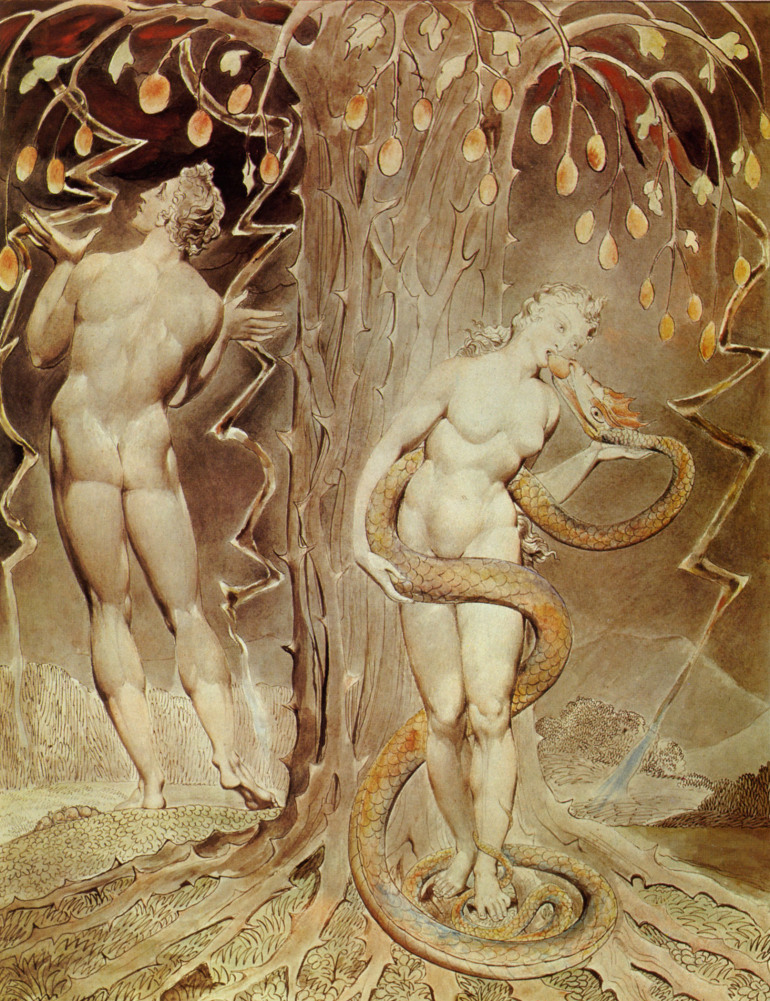
https://youtu.be/AfoJicW0MBM
St Anastasia - An Ancient Commoration for Christmas Day
I offer the following as a complement to your celebrations of the Nativity of Our Lord, not as a replacement! Like someone whose birthday is on Christmas Day, St Anastasia is not often commemorated. At one time, a separate Mass for her was said on December 25th, according to New Advent. I understand that now there is a mention of her in the earliest Mass of the day on the 25th and not mention in the Novus Ordo. I suggest that perhaps in order to revive her momory, as one of the saints of the Roman Canon, we could find a way of adding a veneration to her without distracting from the Nativity - perhaps through the insertion of her name at the prayers of the day in the Mass or the Divine Office in placess where there is flexiblity in prayer, or through a veneration of her icon in the processions in such a way that it supports, rather than distracts from the main focus of the day, the Nativity of the Lord. Perhaps we could take a lead from the Eastern Church which always commemorates the saints of the day even in Sunday liturgy by the singing of the multiple troparia (one-verse hymns) of the day at the appropriate juncture.
Not much is know about the saint, except that she was a Roman by birth who was martyred at Sirmium in modern-day Serbia during the persecution of the Emporer Diocletian. You can read about her in New Advent here.
This Western depiction of her shows her with the idealized features of a Greek goddess as would have been the norm in the neo-classical art of, for example, the High Renaissance or of the early 19th century.

Eastern icons of her show her with a bottle as 'deliver from potion' symbolising the power of her prayers to cure the sick.
![]()

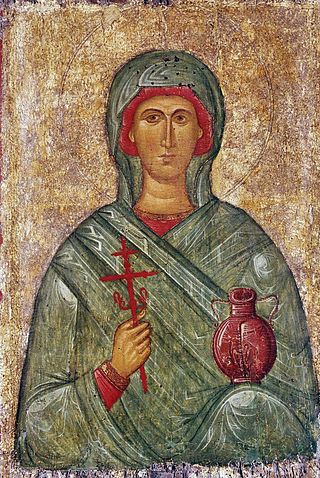
This is one of a series of articles written to highlight the great feasts and the saints of the Roman Canon. All are connected to a single opening essay, in which I set out principles by which we might create a canon of art for Roman Rite churches, and a schema that would guide the placement of such images in a church. (Read it here.) In these, I plan to cover the key elements of images of the Saints of the Roman Canon - Eucharistic Prayer I - and the major feasts of the year. I have created the tag Canon of Art for Roman Rite to group these together, should any be interested in seeing these articles as they accumulate. For the fullest presentation of the principles of sacred art for the liturgy, take the Master’s of Sacred Arts, www.Pontifex.Uni
Aesthetics for Artists and Art Lovers - Learn About Cosmic Beauty
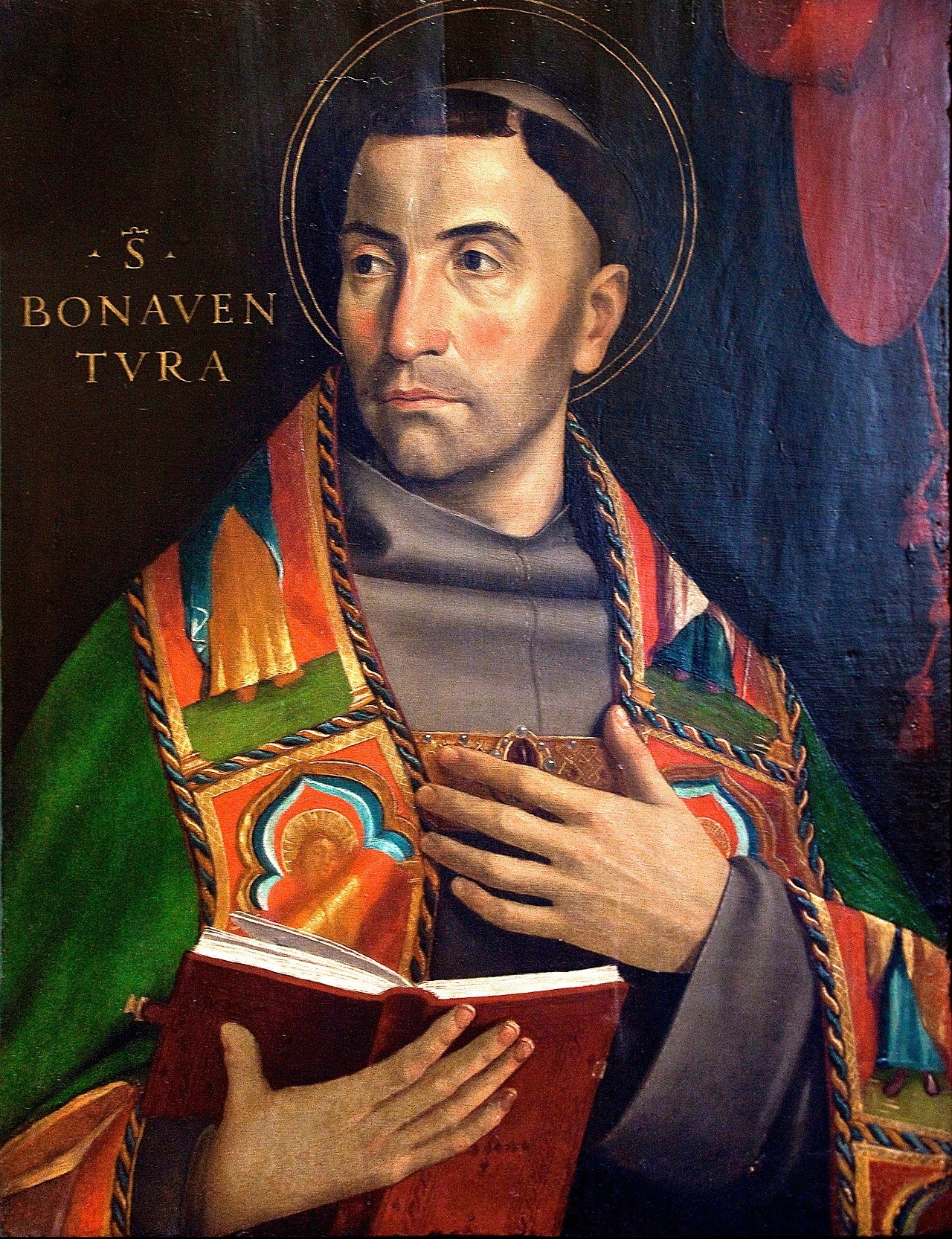 A Survey of the Philosophy of the Good, the True and the Beautiful. An Online Course taught by Dr Carrie Gress for Pontifex University
A Survey of the Philosophy of the Good, the True and the Beautiful. An Online Course taught by Dr Carrie Gress for Pontifex University
When I first decided, many years ago now, to become an artist, I wanted to know how to create beautiful art. Given this goal, it seemed obvious, along with all the other aspects of my formation, that I should start reading about beauty itself.
However, to my surprise, I found very little to help me from Catholic writers. Books on aesthetics talked at length about the nature of beauty - and some seemed true (although many didn't) but barely anyone seemed to offer anything that was of practical use to an artist.
Everyone told me to read Jacques Maritain. I'm probably going to commit a heresy that will offend Thomists here, but I wasn't at all convinced by him either. As I read through Art and Scholasticism, which was admittedly, full of complex reasoning about the nature of beauty, I still wanted to ask the question: and how do I use all of this to help me judge what is beautiful? I am an artist, how is all this going help me to decide whether or not to direct the brush to the left or to the right? But there was very little there to help me.
Finally, right at the end of the book, he told us that the embodiment of all that he had been describing was in the paintings of Braques and Picasso. You have to be joking, I thought. I knew that their work was designed so as to promote an anti-Christian worldview, yet he seemed to be unaware of this. After pages and pages of proofs justifying the objectivity of beauty, in the end, even for Maritain it came down to an arbitrary application of personal taste to tell us that beauty is what he happens to like. Why not just forget the first 300 pages, I thought, and tell us that the answers to what is beautiful, is that it is what clever philosophers say it is? This principle of elitism was no different from any university in the country, where the intellectuals use wordy arguments to tell you what they like is good and you're a Philistine if you think differently.
Although many Church Fathers had written about beauty, they didn't treat the subject separately and so it was difficult to know where to find references to it if they were sprinkled across the whole corpus of the writings. St Thomas is one of these.
I was faced with the prospect of reading volumes and volumes of ancient works, in the hope of finding the occasional nugget of wisdom or hope that someone else had done it first. Strangely, the best anthology I could find was a coffee table book, lavishly illustrated, by an atheist who didn't even believe in objective beauty, but nevertheless knew how to represent the arguments clearly - Umberto Eco. The book was called A History of Beauty. It had short quotations bu very little explanation.
Now, finally, we have a course by a Catholic that gives you a thorough survey of the way that beauty, along with its sisters, goodness and truth from which it can't really be separated. It is better than anything I have seen before - taking you from the ancient Greeks right the way through to awful moderns in a systematic and clear presentation.
A Survey of the Philosophy of the Good, the True and the Beautiful is offered as part of Pontifex University's Master of Sacred Arts program and it is taught by Dr Carrie Gress. Some of you may know her through her bestselling book, The Marian Option, or through her regular articles on various websites such as the National Catholic Register. Dr Gress is also an accomplished philosopher, who obtained her PhD in philosophy from Catholic University of America. She has done all that reading that I was baulking at! And has put it all together for the benefit of all in a stimulating and clear presentation.
Dr Gress's wonderful online course will give you an understanding of the different ways that the great and influential figures of the past - Plato, Aristotle, St Bonaventure, St Thomas and the medievals, for example -understood what beauty is. Through this you will be able to form your own view - there is no single Catholic definition by the way, however much we might like it to be the case. Furthermore, by taking the full Master of Sacred Arts program you will understand how to apply what you learn in your own lives and work.
This an introductory philosophy course. The approach is to assume high intelligence but not necessarily a background in philosophical principles. Therefore, anyone can learn from it. She takes the trouble to explain everything from the foundation of first principles and from there guides you right up to the high peaks!
Incidentally, though clearly very important, St Thomas is not the only contributor to this story! There are many people with important and different things to say on the subject. And as Dr Gress is an expert on Jacques Maritain, you can listen to her explanation of his work and decide for yourself what you make of him - you don't have to adopt my point of view!
You can take it as part of the Master of Sacred Arts program or as a stand-alone, for credit or audit. www.Pontifex.University. It is a recorded online course, so you can register at any time, and take it at your own pace.
The painting below is Raphael's famous School of Athens. I suggest that given Dr Gress's course goes from Athens right up to the present day, there isn't a wall big enough to illustrate all the philsophers she talks about!
Cultivating Spiritual Joy! An Advent Meditation by a Priest from the Instute of the Incarnate Word
Simple and Practical Ways to Promote and Preserve Spiritual Joy, Inspired by St Paul
There is a series of wonderful meditations on the Claritas blog at the moment by priests from the Argentian order, the Institute of the Incarnate Word. I wanted to highlight this, and also share with you here third in the series of meditations for this third week of Advent, based upon the readings from last Sunday. It is by Father Nicholas Grace who is in Cowdenbeath in Scotland. It is so refreshing to hear a priest actually confirming something that I have long believed, that happiness is a choice we can make, provided know how to make the choice. This is simple but profound advice!
He writes:
We have a wonderful topic this 3rd Sunday of Advent because the readings the Church presents give us the opportunity to speak about that most desirable Catholic disposition of soul, that is, Spiritual joy.
The readings offer plenty of material for speaking about spiritual joy. The spiritual joy of the glad tidings that Isaiah was asked to bring to the poor or the spiritual Joy expressed in the Psalm we heard. The Psalm which was an echo of Our Lady’s Magnificat, an expression of spiritual Joy in its purest form.
However, we will focus instead on the 2nd reading from the letter of St. Paul where we are encouraged to rejoice always, to rejoice in God.
I would like to focus on three of the means Paul offers to cultivate and maintain spiritual joy. I will mention three ways to pray without ceasing, and three ways to avoid quenching the spirit. Finally, both of these means will be summarized in Paul’s admonition to retain what is good and refrain from what is evil.
First: Paul urges, pray constantly. How is this possible? It is possible in three ways.
1st: He constantly prays who does not neglect the appointed time for prayer. This begs the question, do I have an appointed time for prayer? If not, why not?
2nd: Always cultivate good desires in the heart. “Lord, you hear the desire of the meek”. We pray for the good, we desire the good and we do the good. Prayer is always present in the good things we do. For this reason, the wise man says, “He does not cease praying who does not cease doing good.”
Therefore, to constantly cultivate good desires in the heart, is to constantly cultivate prayer.
3rd way to pray without ceasing is by giving to those in need.
In fact, the Fathers of the Church tell us: “He who always gives alms is the one who always prays, for the person who receives alms, prays for the person who gives alms.” So, he constantly prays who does not neglect the appointed time for prayer, who cultivates a pure heart and who gives to those in need.
Second: Paul urges: do not quench the Spirit. You might ask, how does one quench the unquenchable? The Holy Spirit is indestructible but someone can drive the Spirit away from himself or can inhibit the Spirit’s operation in somebody else.
In somebody else? When somebody wishes to do something generous as a result of the impulse of the Holy Spirit and the person impedes it, he quenches the Holy Spirit. What about in himself? We all know the answer, mortal sin. Every man is tempted, drawn away and enticed. Once enticed, sin is brought to the soul, and sin brings death and death is the departure of the Holy Spirit.
The Holy Spirit abides in us but when we commit grave and deliberate sin, he departs. Sacred Scripture says as much, “For a holy and disciplined spirit will flee from deceit, and will rise and depart from foolish thoughts, and will be ashamed at the approach of unrighteousness.” (Wis. 1:5).
Third: Paul urges us to test everything, I ask you, is this admonition not a great help to having a positive approach to what we have already said?
If we pray constantly will we fail to retain the good? If we implore the Holy Spirit to work in us, if we obey the commandments if we love our neighbor as we love our-self, will we not then refrain from evil? Will our spiritual joy not be bubbling up from inside of us?
The answer is yes, however, the more we pursue the good and fight the bad, not only will our spiritual joy be increased but so will our spiritual crosses. Crosses which we can spurn, leave or lift.
Clearly one shall be disloyal if he spurns it, negligent if he leaves it, but true-hearted if he lifts his cross. Cross-bearing is the highway of holiness because holiness bears all crosses, crosses picked up in the pursuit of the good as well as the battle against the bad, crosses which instead of being born, become embraced, embraced because those same crosses are a fount of that wonderful spiritual joy which is not the cause of holiness but a manifestation of it.
I would like to conclude by wondering out loud what would happen if St. Paul were here. Would we be nervous if he were to ask us if we knew the means to promote and preserve spiritual joy? Certainly not! Would we be nervous if he asked us what it means to pray constantly? Certainly not! for we have just heard that he who prays constantly is he who prays when he says he will, prays because he has good desires and a good heart, prays because he always gives to those with needs, those who in turn pray for him in thanks for his good deeds. Would we be nervous if Paul were to ask us what it means to quench the Holy Spirit? Certainly not! for we have just heard that, he stifles the spirit whoever prevents others from following holy inspirations, or himself follows his own wicked inclinations.
Well, we may have wicked inclinations but we will do everything to curb them, everything to retain what is good and refrain from what is evil. For we are Catholics, specially chosen by God, to give glory to God. We will be strong in faith, perseverant in hope, industrious in charity, joyful in carrying our crosses and quick to help others with theirs, for we know, that just as God has blessed us, so we must bless all persons, for all persons God loves.
The image is a fresco of St Paul by Giotto

St Paul is often protrayed as a stern man, but the account of his life and his letters have always suggested the opposite to me. There are many references to the joy of the Faith in his writing. Happiness is, after all, what we all seek, and there is no doubting from St Paul that it is on offer to Christian. I like the firm, yet gentle and peaceful expression on this painting by Giotto.
Recently Completed Sculpture by Thomas Marsh: the Holy Spouses, Patrons of the Unborn
I was delighted to receive notice of the completion of a major commission by Thomas Marsh.
It is of the Holy Spouses, Patrons of the Unborn and is located at the Shrine of Our Lady of Guadalupe in Bakersfield, CA.
I love the restrained use of color as applied to the bronze. Also, note that the faces are not portraits of a model, but rather they are idealized, taking inspiration from the Greek ideal, that was used by High Renaissance and Baroque masters. This is something that is so important in sacred art, yet is not understood by so many artists who work in naturalistic styles. I explain the reasons why idealization is important in sacred art in an earlier blog post here.
Beautiful art is as important to the creation of a culture of life as the noble political battles fought by those in the Right to Life movement, I suggest!
Below is a detail of the original clay model that the cast was based on:
Thomas has been an advisor to me in the creation of the Masters of Sacred Arts program at www.Pontifex.University, which offers the all-round formation, the Catholic inculturation that would tell an artist how to direct his brush or chisel, and a patron which artists to commission!
He is also the teacher of Deborah Samia who has created one of the two online studio classes required for the MSA program, an Introduction to Sculpting the Figure.
Anthony Visco Atelier for the Sacred Arts Announces Courses for 2018
Anyone who wants to learn to draw and paint in the naturalistic style should consider classes at the atelier of Catholic master artist Anthony Visco. The perfect combination would be to learn your practical artistic skills with Anthony at his Atelier for Sacred Arts and take the Master of Sacred Arts with www.Pontifex.University in order to have the all-round formation and Catholic inculturation that will help direct your brush...and chisel...and crayon!























